Calculation Model for Progressive Residual Surface Subsidence above Mined-Out Areas Based on Logistic Time Function
Abstract
:1. Introduction
- (1)
- Variation of surface subsidence should reflect the fundamental evolution of surface subsidence. This would consider the subsidence from 0 to its maximum value Wmax, the subsidence rate from 0 to the maximum rate Vmax then back to 0, and the subsidence acceleration from 0 to the maximum positive acceleration +amax, then to the maximum negative acceleration −amax, and eventually to 0, as caused by longwall coal mining.
- (2)
- Evolution of the curve of surface subsidence rate should embody the features consistent with observed in situ subsidence rate.
2. Materials and Methods
2.1. Construction of the Logistic Time Function
2.2. Model for Calculating the Surface Dynamic Residual Subsidence
2.3. Parameter Inversion
2.4. Two Studied Areas
2.4.1. Geological Setting and Mining Conditions over Subcritical Mining
2.4.2. Geo-Mining Settings and Field Measurement over Supercritical Mining
3. Results
3.1. Prediction of Surface Dynamic Residual Subsidence over Subcritical Mining
3.1.1. The Features of Surface Subsidence Based on In Situ Investigation
3.1.2. Predictive Result of Dynamic Residual Subsidence
3.2. Calculation for Residual Subsidence over Supercritical Mining
3.2.1. Parameter Inversion
3.2.2. Validation of the Mathematical Model
4. Discussion
4.1. Spatiotemporal Integrity Analysis over Logistic Time Function
4.2. Evolution of Residual Subsidence Coefficient
5. Conclusions
- (1)
- The logistic time function is essentially an ideal mathematical model. It can render the general evolution of surface subsidence from downward surface movement, subsidence rate, and sinking acceleration; the function can be utilized to predict time-dependent surface subsidence induced by an underground mining operation.
- (2)
- Considering the surface subsidence rate over MSP within subsidence basin, the timeline of the entire surface subsidence process from the outset to termination is divided into three periods: the duration period, residual subsidence period, and a long-term subsidence period. Based on this classification and the logistic time function, this study proposes a novel mathematical model for calculating surface progressive residual subsidence. The surface duration period and residual subsidence period are theoretically separated following the threshold of surface subsidence rate. The surface residual subsidence coefficient varies inversely with time and directly with the model parameters involved in the proposed model.
- (3)
- The validation of the mathematical model proposed is verified through field investigations. Back-calculating the parameters with the mathematical model, we found that the greater the volume of in situ data, the more accurate the predictive results of residual surface subsidence becomes. Suppose observation of surface subsidence induced by longwall coal mining is stopped within an active period. In that case, the precision of parameter inversion becomes much lower than that deduced with all of the data. Therefore, it is strongly recommended that subsidence measurement implemented above mined-out voids not be terminated until the surface subsidence rate extends beyond the active period. Only then can back-calculated parameters with field-based data be reliable in predicting forthcoming surface residual subsidence.
Author Contributions
Funding
Acknowledgments
Conflicts of Interest
References
- Salmi, E.F.; Nazem, M.; Karakus, M. Numerical analysis of a large landslide induced by coal mining subsidence. Eng. Geol. 2017, 217, 141–152. [Google Scholar] [CrossRef]
- Vervoort, A.; Declercq, P. Surface movement above old coal longwalls after mine closure. Int. J. Min. Sci. Technol. 2017, 27, 481–490. [Google Scholar] [CrossRef]
- Vervoort, A. The Time Duration of the Effects of Total Extraction Mining Methods on Surface Movement. Energies 2020, 13, 4107. [Google Scholar] [CrossRef]
- Guo, Q.; Meng, X.; Li, Y.; Lv, X.; Liu, C. A prediction model for the surface residual subsidence in an abandoned goaf for sustainable development of resource-exhausted cities. J. Clean. Prod. 2021, 279, 123803. [Google Scholar] [CrossRef]
- Tajdu’s, K.; Sroka, A.; Misa, R.; Hager, S.; Rusek, J.; Dudek, M.; Wollnik, F. Analysis of Mining-Induced Delayed Surface Subsidence. Minerals 2021, 11, 1187. [Google Scholar] [CrossRef]
- British Petroleum. BP Statistical Review of World Energy 2020|69th Edition [R/OL]; Royal Dutch/Shell Group: London, UK, 2021; Available online: https://www.bp.com/en/global/corporate/energy-economics/statistical-review-of-world-energy.html (accessed on 5 March 2022).
- National Bureau of Statistics. China Statistical Yearbook 2020; China Statistical Press: Beijing, China, 2021. [Google Scholar]
- Marian, D.; Onica, I. Analysis of the Geomechanical Phenomena that led to the appearance of sinkholes at the Lupeni Mine, Romania, in the conditions of thick coal seams mining with longwall top coal caving. Sustainability 2021, 13, 6449. [Google Scholar] [CrossRef]
- Cai, Y.; Li, X.; Xiao, W.; Zhang, W. Simulation of Mining-Induced Ground Damage Using Orthogonal Experiments to Determine Key Parameters of Super-Large Coalface: A Case Study in Shendong Coalfield in China. Appl. Sci. 2020, 10, 2258. [Google Scholar] [CrossRef] [Green Version]
- Booth, C. Groundwater as an environmental constraint of longwall coal mining. Environ. Geol. 2006, 49, 796–803. [Google Scholar] [CrossRef]
- Loupasakis, C.; Angelitsa, V.; Rozos, D. Mining geohazards—Land subsidence caused by the dewatering of opencast coal mines: The case study of the Amyntaio coal mine, Florina, Greece. Nat. Hazards 2014, 70, 675–691. [Google Scholar] [CrossRef]
- China National Coal Association. Coal Industry Development Report 2020 of China [EB/OL]. 2021. Available online: http://www.coalchina.org.cn (accessed on 7 March 2022).
- He, S.; Lee, J.; Zhou, T.; Wu, D. Shrinking cities and resource-based economy: The economic restructuring in China’s mining cities. Cities 2017, 60, 75–83. [Google Scholar] [CrossRef]
- The State Council. Several Opinions of the State Council on Promoting the Sustainable Development of Resource-Based Cities. Government Document, 2007. Available online: https://wenku.baidu.com/view/347d5b690266f5335a8102d276a20029bd6463ba.html (accessed on 7 March 2022).
- The State Council. The Plan for the Sustainable Development of Resource-Based Cities in China (2013–2020). Government Document, 2013. Available online: http://www.gov.cn/zfwj/2013-12/03/content_2540070.htm (accessed on 7 March 2022).
- Cui, X.; Zhao, Y.; Wang, G.; Zhang, B.; Li, C. Calculation of Residual Surface Subsidence Above Abandoned Longwall Coal Mining. Sustainability 2020, 12, 1528. [Google Scholar] [CrossRef] [Green Version]
- Peng, S.S. Coal Mine Ground Control; Department of Mining Engineering, West Virginia University: Morgantown, WV, USA, 2006. [Google Scholar]
- Cui, X.; Wang, J.; Liu, Y. Prediction of progressive surface subsidence above longwall coal mining using a time function. J. Rock Mech. Min. 2001, 38, 1057–1063. [Google Scholar] [CrossRef]
- Peng, S.S. Surface Subsidence Engineering; The Society for Mining, Metallurgy, and Exploration, Inc.: Englewood, CO, USA, 1992. [Google Scholar]
- He, G.; Yang, L.; Ling, G. Mining Subsidence; Coal Industry Press: Beijing, China, 1992. [Google Scholar]
- Guo, W. Coal Mining Impairment and Protection; Coal Industry Press: Beijing, China, 2013. [Google Scholar]
- Asadi, A.; Shakhriar, K.; Goshtasbi, K. Profiling function for surface subsidence prediction in mining inclined coal seams. J. Min. Sci. 2004, 40, 142–146. [Google Scholar] [CrossRef]
- Ren, G.; Li, G.; Kulessa, M. Application of a Generalised Influence Function Method for Subsidence Prediction in Multi-seam Longwall Extraction. Geotech. Geol. Eng. 2014, 32, 1123–1131. [Google Scholar] [CrossRef]
- Cui, X.; Li, C.; Hu, Q.; Miao, X. Prediction of surface subsidence due to underground mining based on the zenith angle. Int. J. Rock Mech. Min. 2013, 60, 246–252. [Google Scholar] [CrossRef]
- Nicieza, C.; Fernandez, M. The new three-dimensional subsidence influence function denoted by n-k-g. Int. J. Rock Mech. Min. 2005, 42, 372–387. [Google Scholar] [CrossRef]
- Lokhande, R.; Murthy, V.; Singh, K. Predictive models for pot-hole depth in underground coalmining—Some Indian experiences. Arab. J. Geosci. 2014, 7, 4697–4705. [Google Scholar] [CrossRef]
- Yuan, Y.; Li, H.; Zhang, H.; Zhang, Y.; Zhang, X. Improving Reliability of Prediction Results of Mine Surface Subsidence of Northern Pei County for Reusing Land Resources. Appl. Sci. 2020, 10, 8385. [Google Scholar] [CrossRef]
- Xu, J.; Zhu, W.; Xu, J.; Wu, J.; Li, Y. High-intensity longwall mining-induced ground subsidence in Shendong coalfield, China. Int. J. Rock Mech. Min. 2021, 141, 104730. [Google Scholar] [CrossRef]
- Hu, B.; Zhang, H.; Shen, B. Specification for Coal Pillar Retention/Retaining and Coal Mining under Buildings, Water Bodies, Railways and Main/Major Roadways; Coal Industry Publishing Press: Beijing, China, 2017. [Google Scholar]
- Zheng, M.; Deng, K.; Fan, H.; Du, S. Monitoring and Analysis of Surface Deformation in Mining Area Based on InSAR and GRACE. Remote Sens. 2018, 10, 1392. [Google Scholar] [CrossRef] [Green Version]
- Modeste, G.; Doubre, C.; Masson, F. Time evolution of mining-related residual subsidence monitored over a 24-year period using InSAR in southern Alsace, France. Int. J. Appl. Earth Obs. Geoinf. 2021, 102, 102392. [Google Scholar] [CrossRef]
- Guéguen, Y.; Deffontaines, B.; Fruneau, B.; Heib, M.; Michele, M.; Raucoules, D.; Guise, Y.; Planchenault, J. Monitoring residual mining subsidence of Nord/Pas-de-Calais coal basin from differential and Persistent Scatterer Interferometry (Northern France). J. Appl. Geophys. 2009, 69, 24–34. [Google Scholar] [CrossRef]
- Bazaluk, O.; Rysbekov, K.; Nurpeisova, M.; Lozynskyi, V.; Kyrgizbayeva, G.; Turumbetov, T. Integrated monitoring for the rock mass state during large-scale subsoil development. Front. Environ. Sci. 2022, 10, 852591. [Google Scholar] [CrossRef]
- Chen, D.; Chen, H.; Zhang, W.; Cao, C.; Zhu, K.; Yuan, X.; Du, Y. Characteristics of the Residual Surface Deformation of Multiple Abandoned Mined-Out Areas Based on a Field Investigation and SBAS-InSAR: A Case Study in Jilin, China. Remote Sens. 2020, 12, 3752. [Google Scholar] [CrossRef]
- Blachowski, J.; Kope´, A.; Milczarek, W.; Owczarz, K. Evolution of Secondary Deformations Captured by Satellite Radar Interferometry: Case Study of an Abandoned Coal Basin in SW Poland. Sustainability 2019, 11, 884. [Google Scholar] [CrossRef] [Green Version]
- Li, C.; Gao, Y.; Cui, X.; Yuan, D.; He, R. Spatiotemporal evolution of surface subsidence induced by fully-mechanized thick coal underground mining in Yunjialing colliery. J. Min. Saf. Eng. 2019, 36, 37–43. [Google Scholar] [CrossRef]
- Knothe, S. Effect of time on formation of basin subsidence. Arch. Min. Steel Ind. 1953, 1, 1–7. [Google Scholar]
- Wang, B.; Xu, J.; Xuan, D. Time function model of dynamic surface subsidence assessment of grout-injected overburden of a coal mine. Int. J. Rock Mech. Min. 2018, 104, 1–8. [Google Scholar] [CrossRef]
- Zhang, L.; Cheng, H.; Yao, Z.; Wang, X. Application of the Improved Knothe Time Function Model in the Prediction of Ground Mining Subsidence: A Case Study from Heze City, Shandong Province, China. Appl. Sci. 2020, 10, 3147. [Google Scholar] [CrossRef]
- Kwinta, A.; Hejmanowski, R.; Sorka, A. A time function analysis used for the prediction of rock mass subsidence. In Proceedings of the International Symposium on Mining Science and Technology, Xuzhou, China, 16–18 October 1996; pp. 419–424. [Google Scholar]
- Gonzalez-Nicieza, C.; Alvarez-Fernandez, M.; Menendez-Diaz, A.; Alvarez-Vigil, A. The influence of time on subsidence in the Central Asturian Coal field. Bull. Eng. Geol. Environ. 2007, 66, 319–329. [Google Scholar] [CrossRef]
- Peng, X.; Cui, X.; Zang, Y. Time function and prediction of progressive surface movements and deformations. J. Univ. Sci. Technol. Beijing 2004, 26, 341–344. [Google Scholar] [CrossRef] [Green Version]
- Nie, L.; Wang, H.; Xu, Y. Application of the arctangent function model in the prediction of ground mining subsidence deformation: A case study from Fushun City, Liaoning Province, China. Bull. Eng. Geol. Environ. 2017, 76, 1383–1398. [Google Scholar] [CrossRef]
- Kowalaki, A. Surface subsidence and rate of its increments based on measurements and theory. Arch. Min. Sci. 2001, 46, 391–406. [Google Scholar]
- Hu, H.; Zhao, Y.; Kang, J.; Liang, W. Related laws and verification of mined-out area span, time and residual deformation. Chin. J. Rock Mech. Eng. 2008, 27, 65–71. [Google Scholar] [CrossRef]
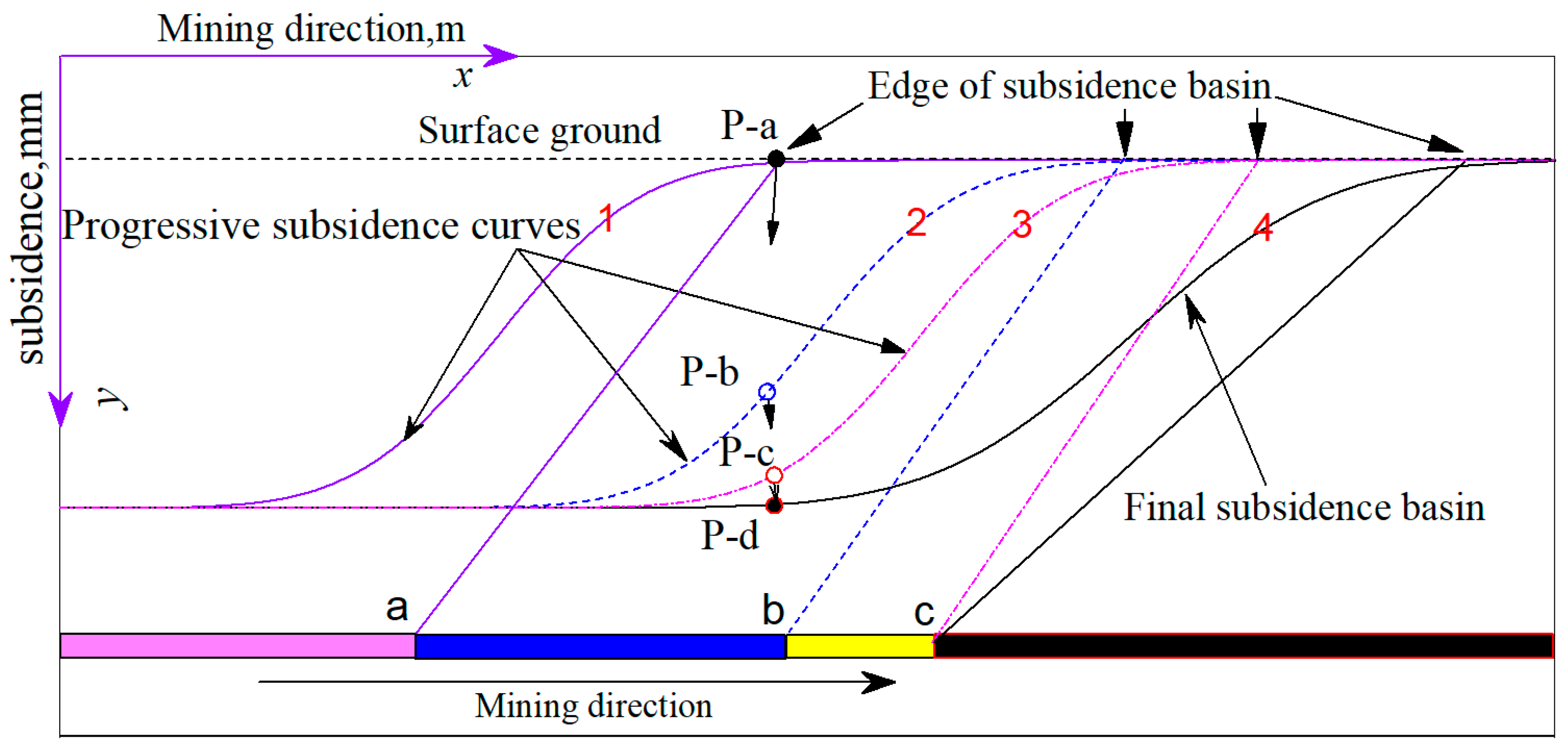

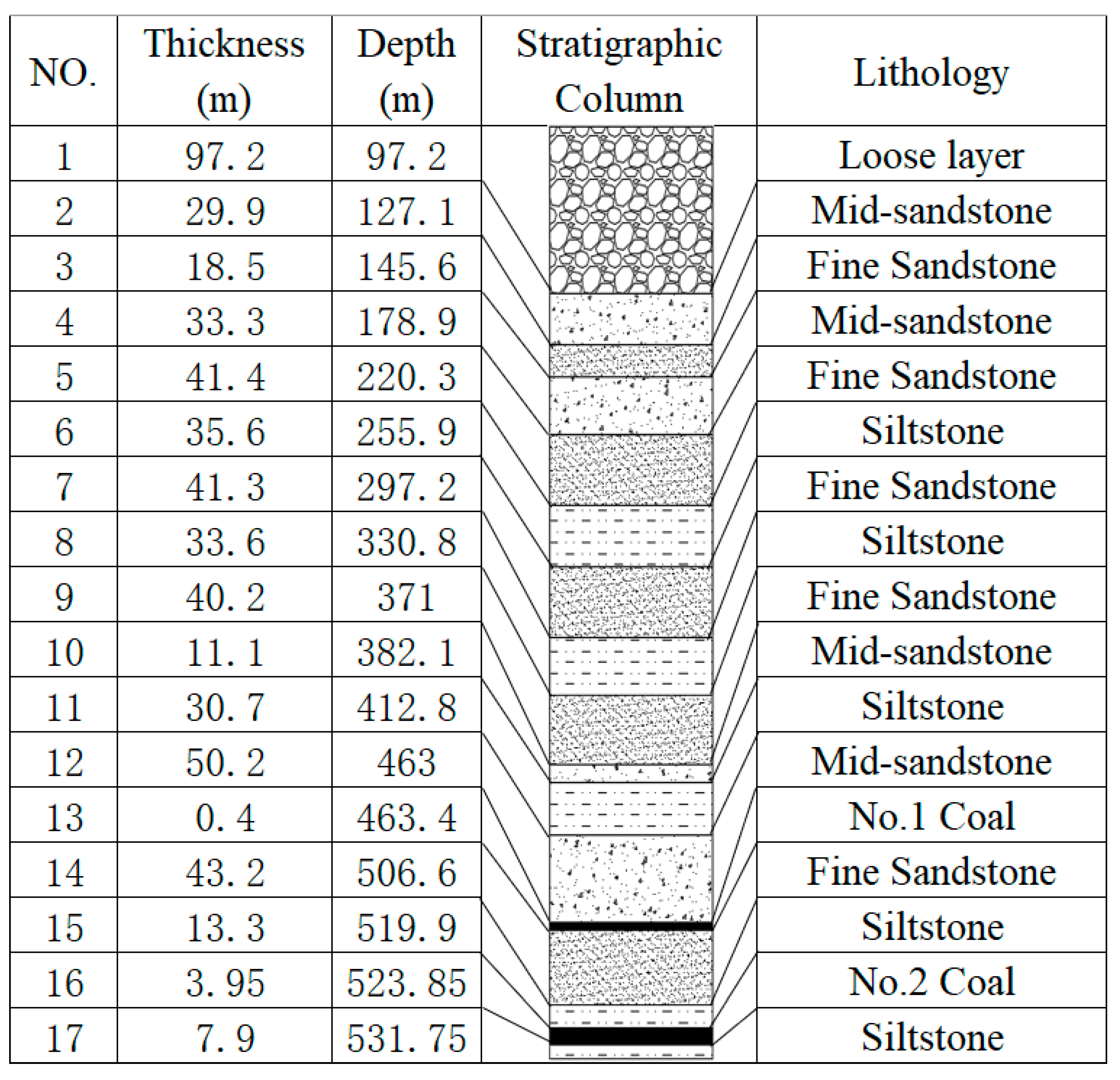
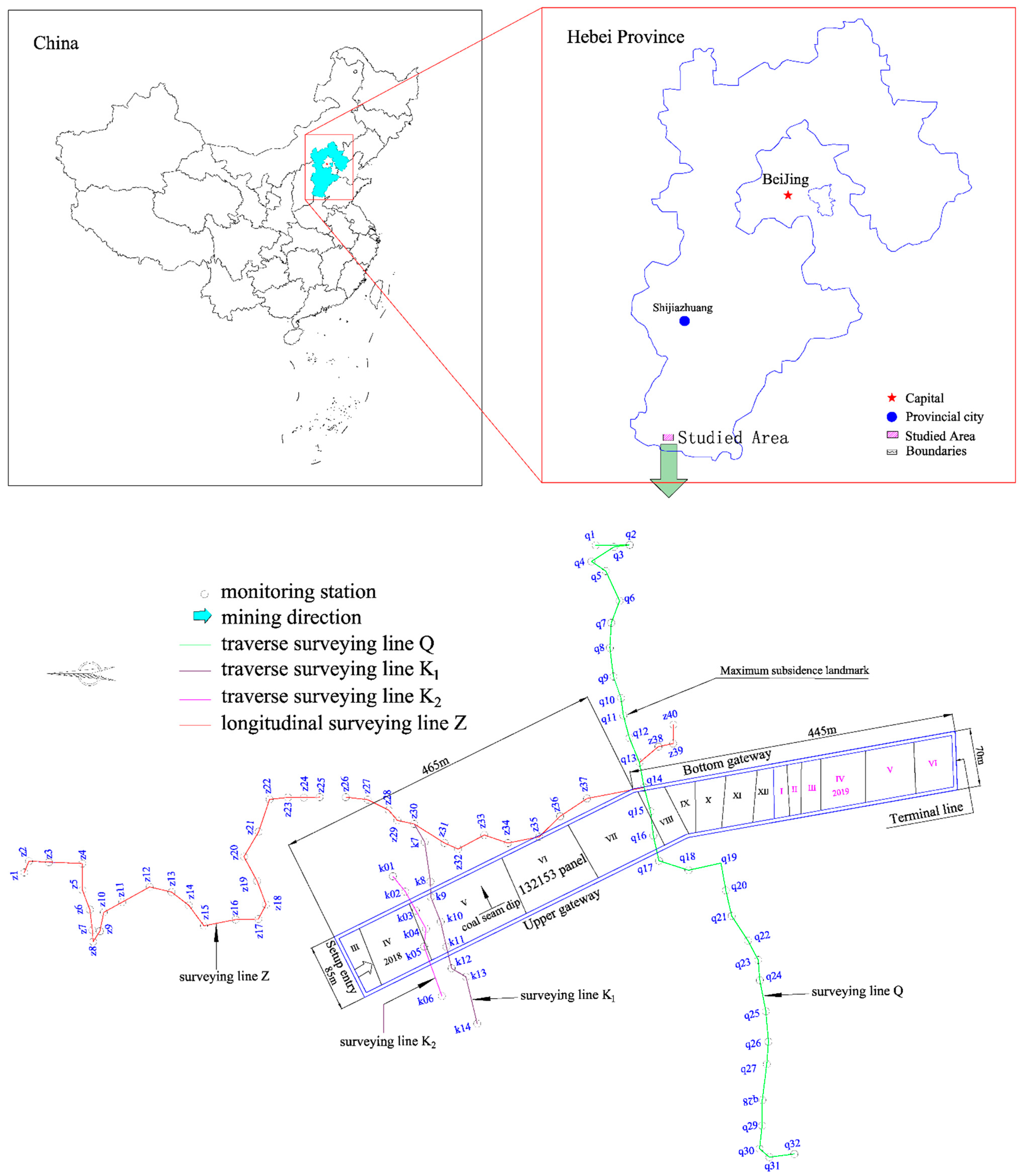
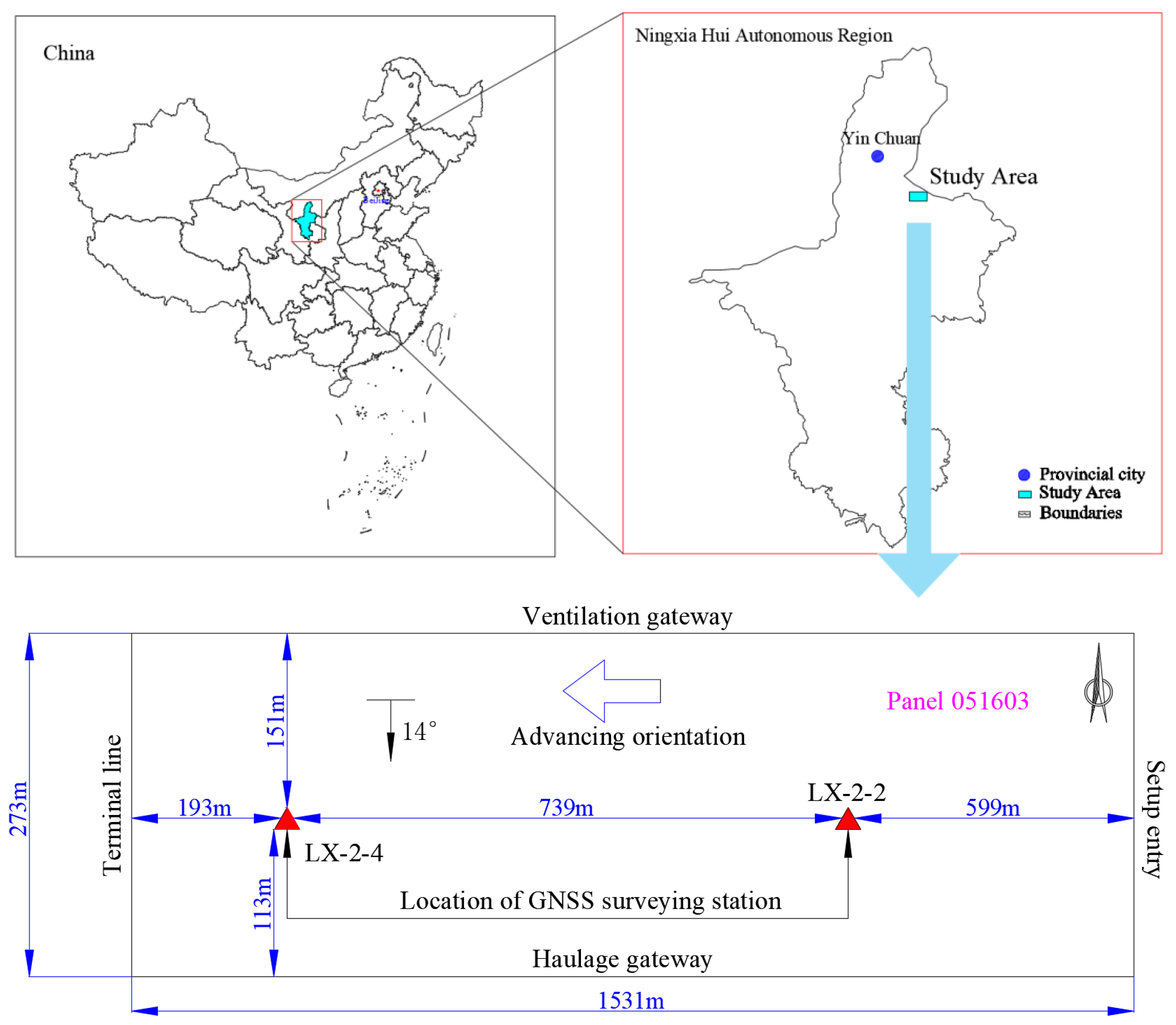
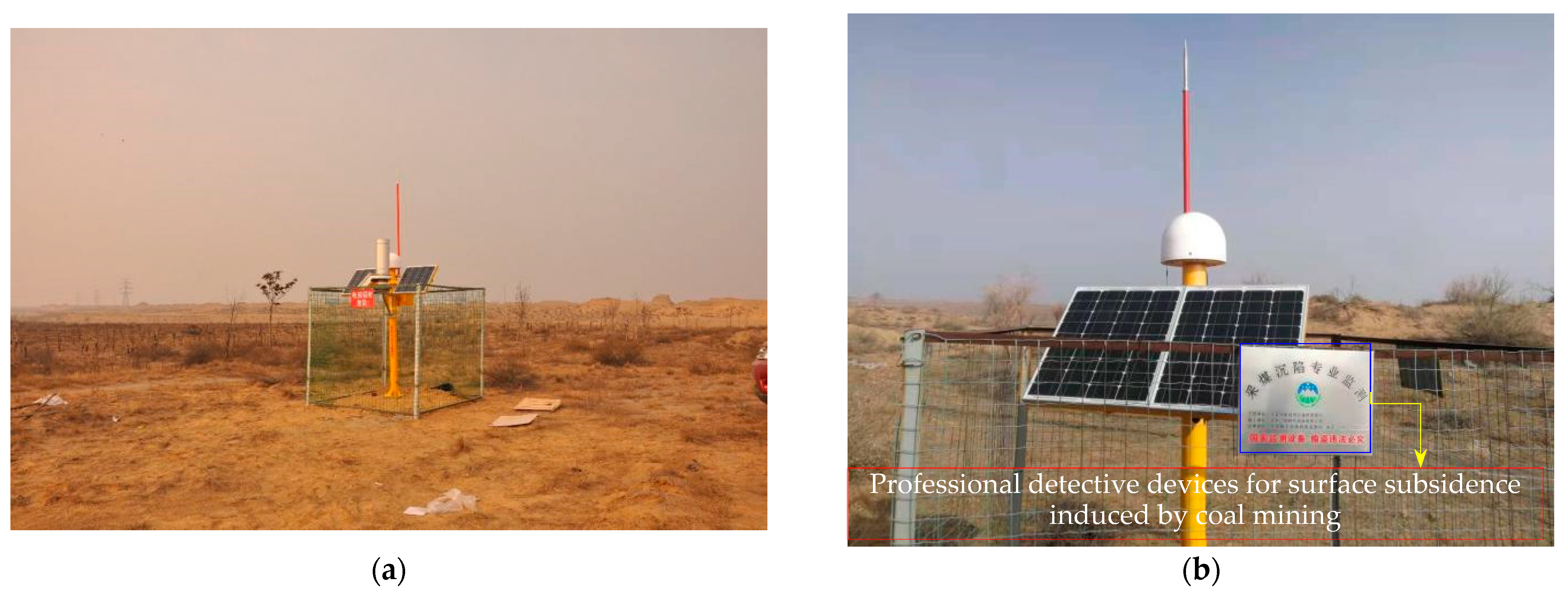

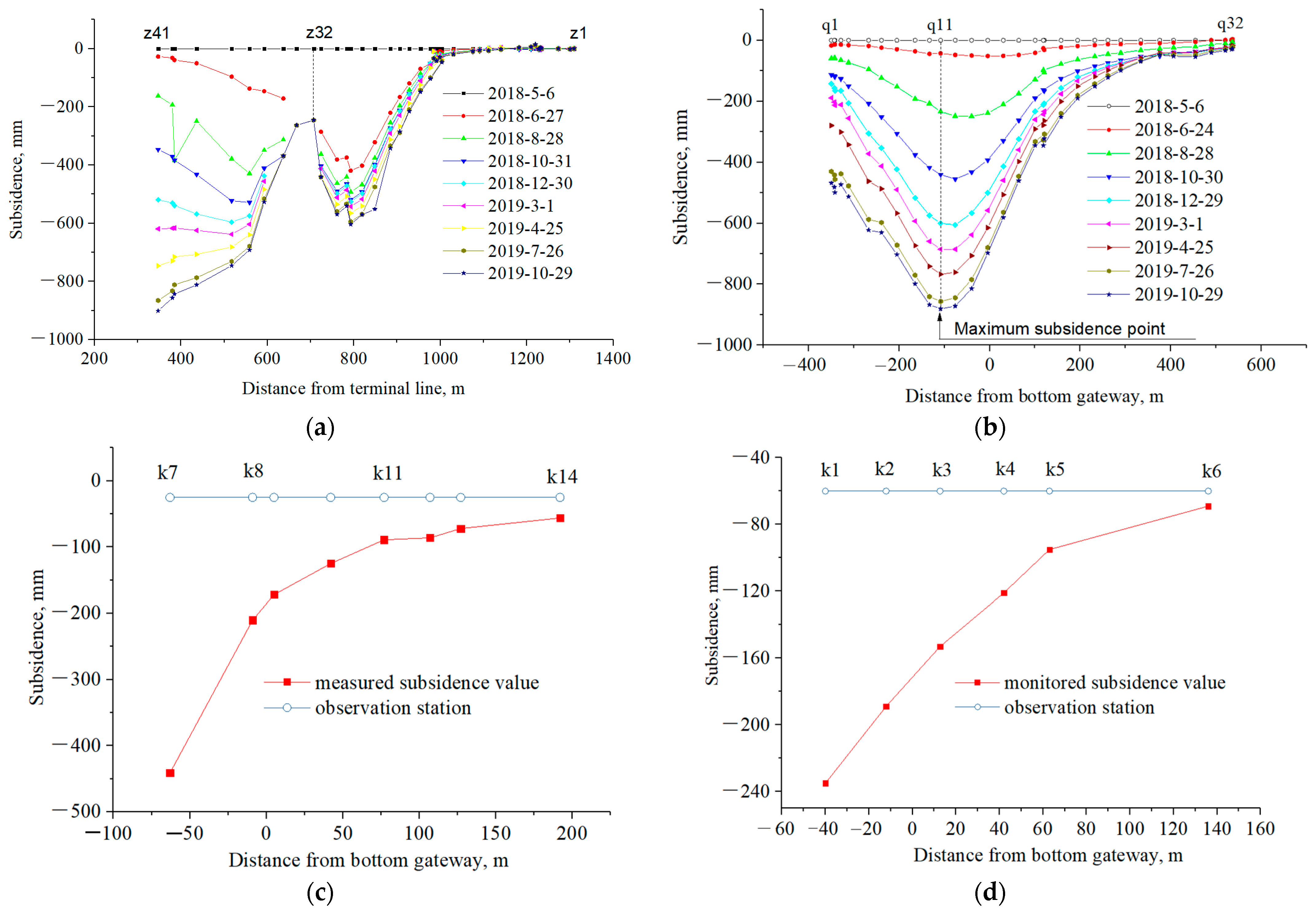
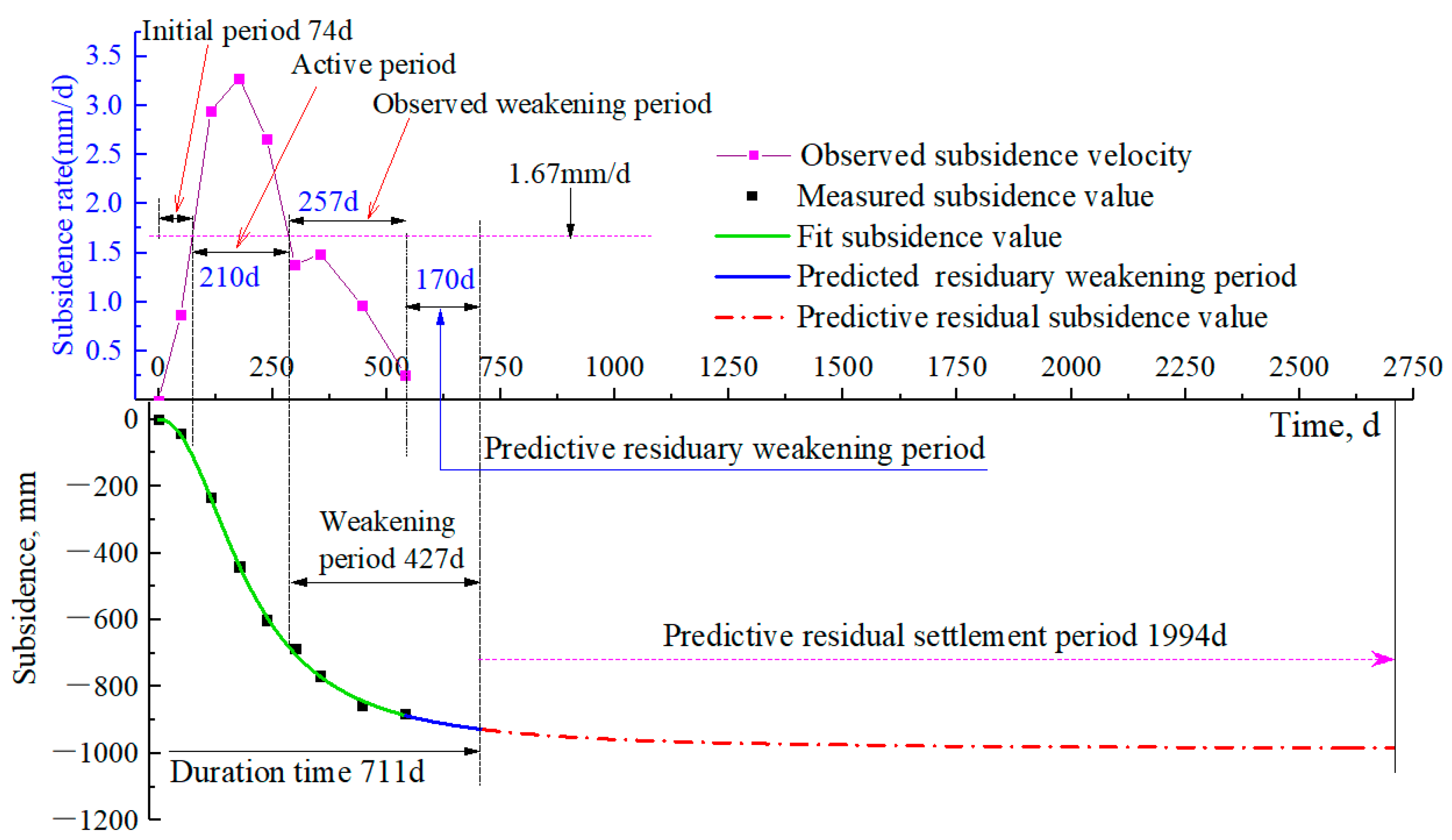
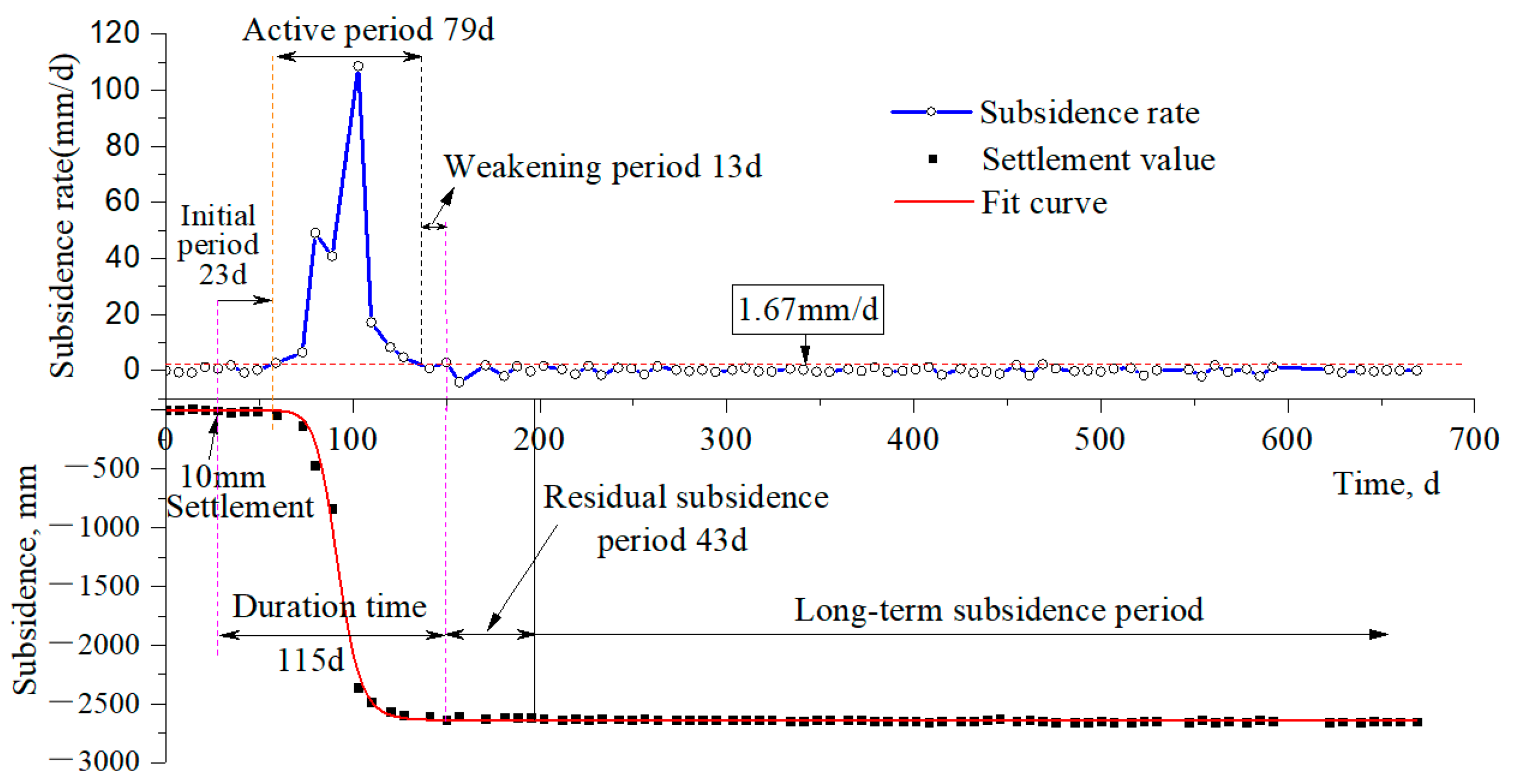

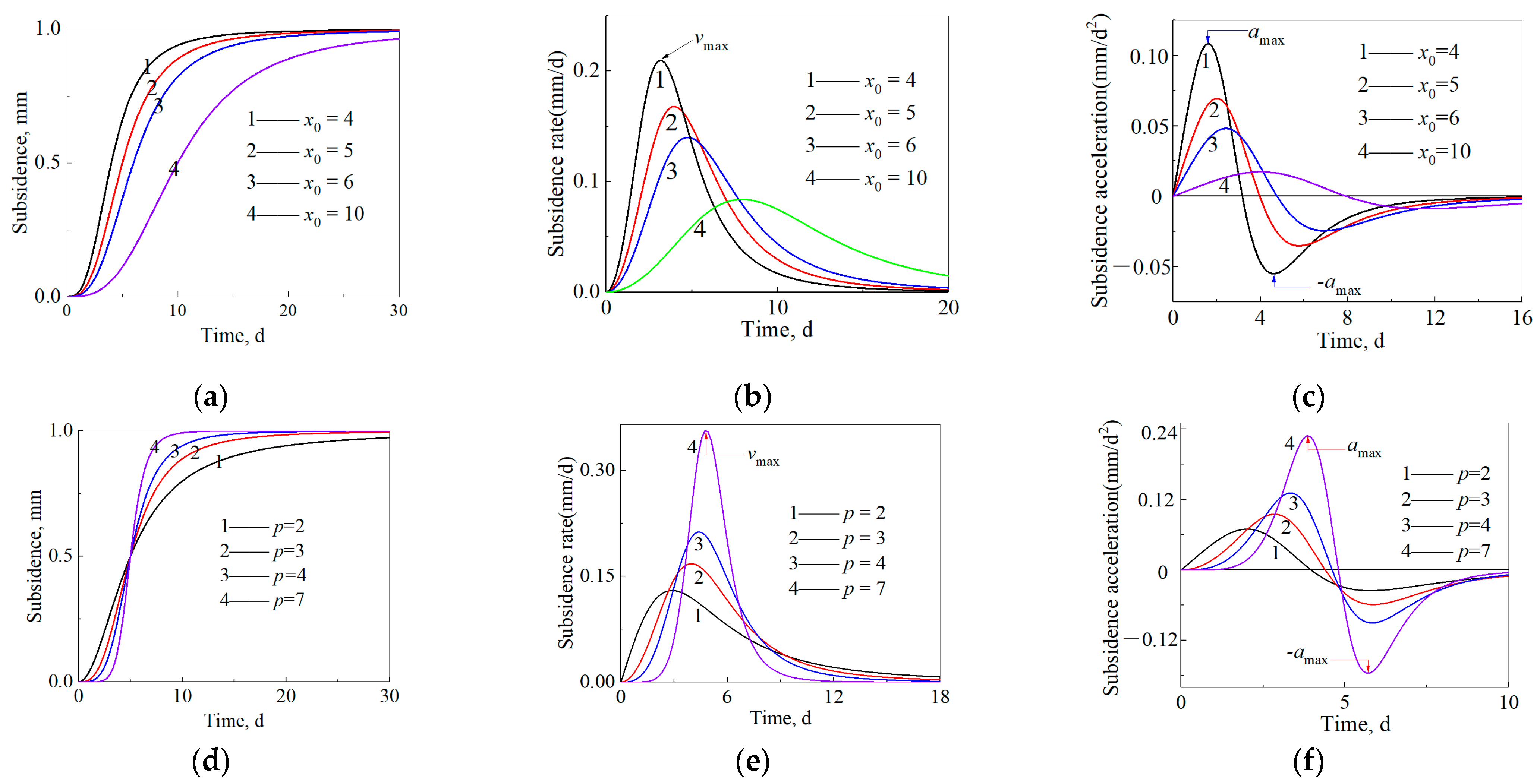
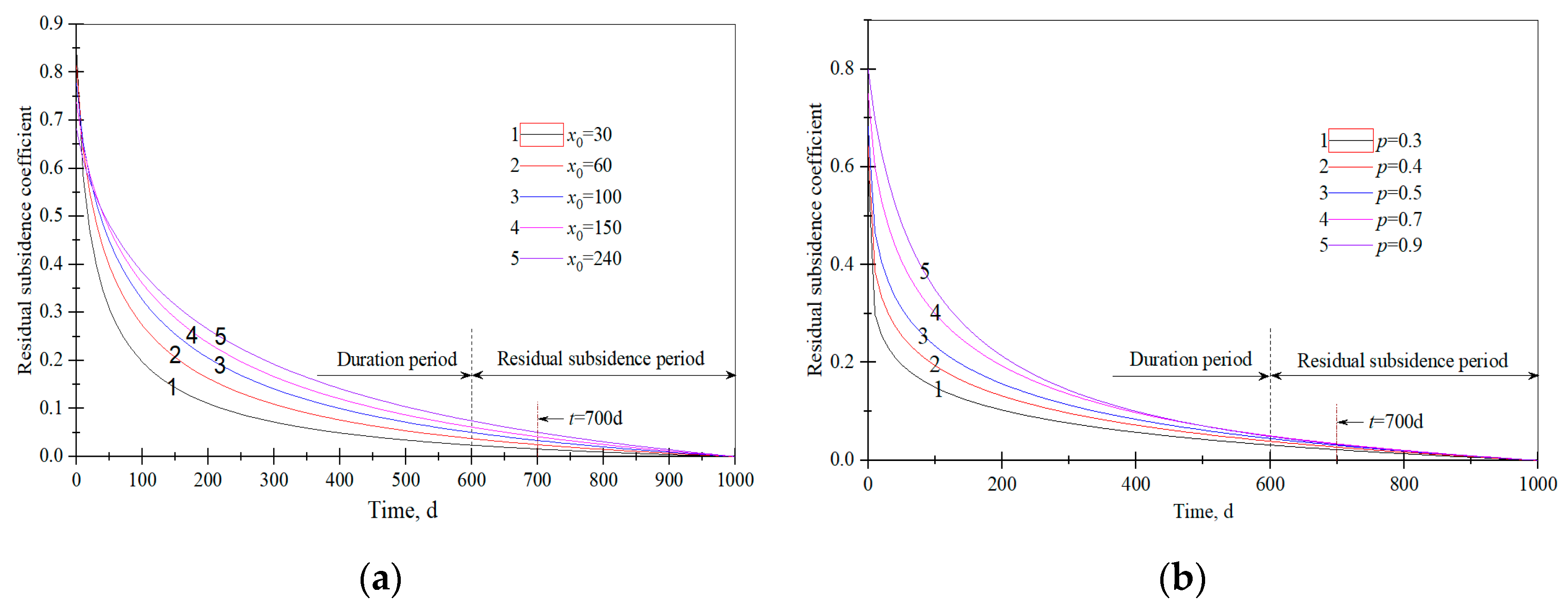
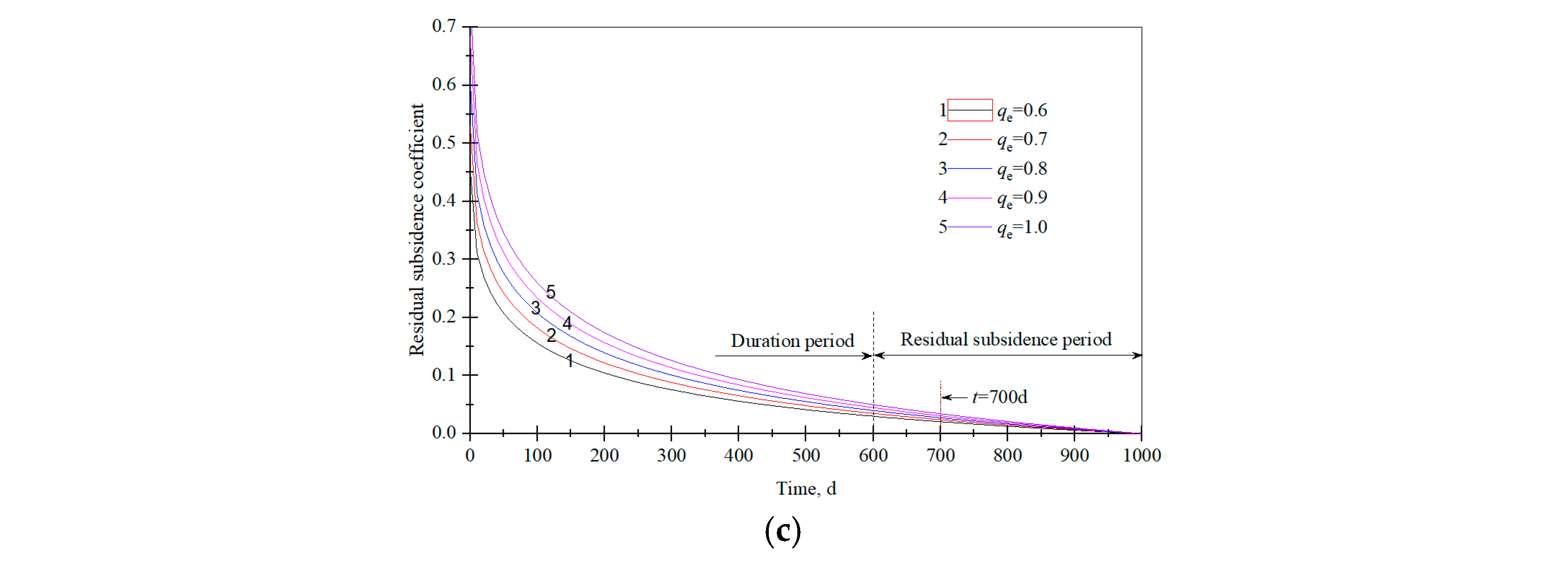
| Time-Section | Time, d | Period | Max. Subsidence Value, mm | Derived Model Parameters | R-Square | Maximum Deviation, mm | RMSE, mm | ||
|---|---|---|---|---|---|---|---|---|---|
| q | x0 | p | R2 | ||||||
| 7 February 2015–28 May 2015 | 110 | Active | 2479 | 0.992 | 93.77 | 12.91 | 0.993 | 272 | ±249 |
| 7 February 2015–7 June 2015 | 120 | Active | 2563 | 0.923 | 92.36 | 14.56 | 0.994 | 82 | ±48 |
| 7 February 2015–28 June 2015 | 141 | Weakening | 2605 | 0.905 | 92.02 | 15.21 | 0.996 | 34 | ±11 |
| 7 February 2015–14 August 2015 | 188 | Residual | 2618 | 0.901 | 91.93 | 15.41 | 0.997 | 35 | ±9 |
| 7 February 2015–7 December 2016 | 669 | Long-term | 2649 | 0.906 | 92.04 | 15.16 | 0.998 | - | - |
Publisher’s Note: MDPI stays neutral with regard to jurisdictional claims in published maps and institutional affiliations. |
© 2022 by the authors. Licensee MDPI, Basel, Switzerland. This article is an open access article distributed under the terms and conditions of the Creative Commons Attribution (CC BY) license (https://creativecommons.org/licenses/by/4.0/).
Share and Cite
Li, C.; Ding, L.; Cui, X.; Zhao, Y.; He, Y.; Zhang, W.; Bai, Z. Calculation Model for Progressive Residual Surface Subsidence above Mined-Out Areas Based on Logistic Time Function. Energies 2022, 15, 5024. https://doi.org/10.3390/en15145024
Li C, Ding L, Cui X, Zhao Y, He Y, Zhang W, Bai Z. Calculation Model for Progressive Residual Surface Subsidence above Mined-Out Areas Based on Logistic Time Function. Energies. 2022; 15(14):5024. https://doi.org/10.3390/en15145024
Chicago/Turabian StyleLi, Chunyi, Laizhong Ding, Ximin Cui, Yuling Zhao, Yihang He, Wenzhi Zhang, and Zhihui Bai. 2022. "Calculation Model for Progressive Residual Surface Subsidence above Mined-Out Areas Based on Logistic Time Function" Energies 15, no. 14: 5024. https://doi.org/10.3390/en15145024






